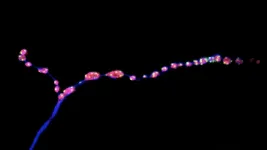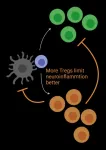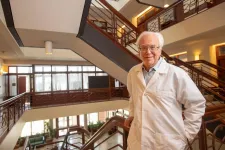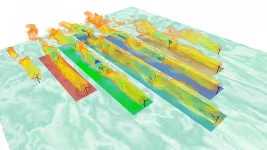Enzyme-based plastics recycling is more energy efficient, better for environment
BOTTLE Consortium effort develops model that finds sizeable energy and carbon-saving benefits for recycling PET, a common plastic used in bottles, clothing, carpet
2021-07-20
(Press-News.org) Researchers in the BOTTLE Consortium, including from the U.S. Department of Energy's (DOE's) National Renewable Energy Laboratory (NREL) and the University of Portsmouth, have identified using enzymes as a more sustainable approach for recycling polyethylene terephthalate (PET), a common plastic in single-use beverage bottles, clothing, and food packaging that are becoming increasingly relevant in addressing the environmental challenge of plastic pollution. An analysis shows enzyme-recycled PET has potential improvement over conventional, fossil-based methods of PET production across a broad spectrum of energy, carbon, and socioeconomic impacts.
The concept, if further developed and implemented at scale, could lead to new opportunities for PET recycling and create a mechanism for recycling textiles and other materials also made from PET that are traditionally not recycled today. PET ranks among the most abundantly produced synthetic polymers in the world, with 82 million metric tons produced annually; roughly 54% of PET is used in the manufacture of textiles for clothing and fibers for carpet.
"From all the plastics that were produced since the 1950s, less than 10% of it has ever been recycled," said Avantika Singh, a chemical engineer at NREL and first author of a new paper outlining the path toward enzyme-based recycling. "Most waste plastics end up in landfills."
The paper, "Techno-economic, life-cycle, and socioeconomic impact analysis of enzymatic recycling of poly(ethylene terephthalate)," appears in the journal Joule. Her coauthors are Nicholas Rorrer, Scott Nicholson, Erika Erickson, Jason DesVeaux, Andre Avelino, Patrick Lamers, Arpit Bhatt, Yi Min Zhang, Greg Avery, Ling Tao, Alberta Carpenter, and Gregg Beckham, all from NREL; and John McGeehan and Andrew Pickford of the University of Portsmouth's Centre for Enzyme Innovation in the United Kingdom, who are also members of BOTTLE.
BOTTLE is striving to address the problem of plastic pollution with two innovative approaches, namely to: (1) develop energy-efficient, cost-effective, and scalable recycling and upcycling technologies and (2) design modern plastics to be recyclable by design.
The new research paper addresses the challenge of plastic recyclability. While images of discarded bottles floating in oceans and other waterways provide a visual reminder of the problems posed by plastic waste, the lesser-seen issue remains of what to do with the PET used to manufacture textiles for clothing and fibers for carpet.
The researchers modeled a conceptual recycling facility that would take in a fraction of the 3 million metric tons of PET consumed annually in the United States. The enzymatic recycling process breaks down PET into its two building blocks, terephthalic acid (TPA) and ethylene glycol. Compared to conventional fossil-based production routes, the research team determined the enzymatic recycling process can reduce total supply-chain energy use by 69%-83% and greenhouse gas emissions by 17%-43% per kilogram of TPA. Additionally, an economy-wide comparison of virgin TPA and recycled TPA in the United States shows that the environmental and socioeconomic effects of the two processes are not distributed equally across their supply chain. The proposed recycling process can reduce environmental impacts by up to 95%, while generating up to 45% more socioeconomic benefits, including local jobs at the material recovery facilities.
The study also predicts that enzymatic PET recycling can achieve cost parity with the production of virgin PET, thus highlighting the potential for this enzyme technology to decarbonize PET manufacturing, in addition to enabling the recycling of waste PET-rich feedstocks, such as clothing and carpets.
"That's one of the biggest opportunities," Singh said. "If we can capture that space--textiles, carpet fibers, and other PET waste plastics that are not currently recycled--that could be a true game-changer."
INFORMATION:
This research is funded by DOE's Advanced Manufacturing Office and the Bioenergy Technologies Office. The work was done as part of the Bio-Optimized Technologies to keep Thermoplastics out of Landfills and the Environment (BOTTLE) Consortium.
NREL is the U.S. Department of Energy's primary national laboratory for renewable energy and energy efficiency research and development. NREL is operated for the Energy Department by the Alliance for Sustainable Energy, LLC.
ELSE PRESS RELEASES FROM THIS DATE:
2021-07-20
Neurons communicate through rapid electrical signals that regulate the release of neurotransmitters, the brain's chemical messengers. Once transmitted across a neuron, electrical signals cause the juncture with another neuron, known as a synapse, to release droplets filled with neurotransmitters that pass the information on to the next neuron. This type of neuron-to-neuron communication is known as evoked neurotransmission.
However, some neurotransmitter-packed droplets are released at the synapse even in the absence of electrical impulses. These miniature release events -- or ...
2021-07-20
Every spring, the Daylight Saving Time shift robs people of an hour of sleep - and a new study shows that DNA plays a role in how much the "spring forward" time change affects individuals.
People whose genetic profile makes them more likely to be "early birds" the rest of the year can adjust to the time change in a few days, the study shows. But those who tend to be "night owls" could take more than a week to get back on track with sleep schedule, according to new data published in Scientific Reports by a team from the University of Michigan.
The study uses data from continuous sleep tracking ...
2021-07-20
Forensics specialists can use a commercial assay targeting mitochondrial DNA to accurately discriminate between wolf, coyote and dog species, according to a new study from North Carolina State University. The genetic information can be obtained from smaller or more degraded samples, and could aid authorities in prosecuting hunting jurisdiction violations and preserving protected species.
In the U.S., certain wolf subspecies or species are endangered and restricted in terms of hunting status. It is also illegal to deliberately breed wolves or coyotes with domesticated dogs.
"If ...
2021-07-20
EAST LANSING, Mich. - Diagnosing a rare medical condition is difficult. Identifying a treatment for it can take years of trial and error. In a serendipitous intersection of research expertise, an ill patient in this case a child and innovative technology, Bachmann-Bupp Syndrome has gone from a list of symptoms to a successful treatment in just 16 months.
The paper chronicling this lightning-fast scientific response to the Bachmann-Bupp Syndrome was published in the open-access journal, eLife.
For more than 25 years, André Bachmann, professor of pediatrics in Michigan State University College ...
2021-07-20
New research adds to a body of evidence indicating decisions about withdrawing life-sustaining treatment for patients with moderate-to-severe traumatic brain injury (TBI) should not be made in the early days following injury.
In a July 6, 2021, study published in JAMA Neurology, researchers led by UC San Francisco, Medical College of Wisconsin and Spaulding Rehabilitation Hospital followed 484 patients with moderate-to-severe TBI. They found that among the patients in a vegetative state, 1 in 4 "regained orientation" - meaning they knew who they were, their ...
2021-07-20
By Luciana Constantino | Agência FAPESP – A pregnant woman infected by zika virus does not face a greater risk of giving birth to a baby with microcephaly if she has previously been exposed to dengue virus, according to a Brazilian study that compared data for pregnant women in Rio de Janeiro and Manaus.
A zika epidemic broke out in Brazil in 2015-16 in areas where dengue is endemic. Both viruses are transmitted by the mosquito Aedes aegypti. Some of the states affected by the zika epidemic reported a rise in cases of microcephaly, a rare neurological disorder in which the baby’s brain fails to develop completely. Others saw no such rise.
According to this new study by Brazilian researchers, two factors explain the rise in microcephaly in only some areas: the ...
2021-07-20
When it comes to improving access to mental health services for children and families in low-income communities, a University of Houston researcher found having a warm handoff, which is a transfer of care between a primary care physician and mental health provider, will help build trust with the patient and lead to successful outcomes.
"Underserved populations face certain obstacles such as shortage of providers, family beliefs that cause stigma around mental health care, language barriers, lack of transportation and lack of insurance. A warm handoff, someone who serves as a go-between for experts and patients, can ensure connections are made," said Quenette L. Walton, assistant professor at the ...
2021-07-20
Irvine, CA - July 20, 2021 - In a new University of California, Irvine-led study, researchers found that a certain protein prevented regulatory T cells (Tregs) from effectively doing their job in controlling the damaging effects of inflammation in a model of multiple sclerosis (MS), a devastating autoimmune disease of the nervous system.
Published this month in Science Advances, the new study illuminates the important role of Piezo1, a specialized protein called an ion channel, in immunity and T cell function related to autoimmune neuroinflammatory disorders.
"We found that Piezo1 selectively restrains Treg cells, limiting their potential to mitigate ...
2021-07-20
Newborns at risk for Type 1 diabetes because they were given antibiotics may have their gut microorganisms restored with a maternal fecal transplant, according to a Rutgers study.
The study, which involved genetic analysis of mice, appears in the journal Cell Host & Microbe.
The findings suggest that newborns at risk for Type 1 diabetes because their microbiome - the trillions of beneficial microorganisms in and on our bodies - were disturbed can have the condition reversed by transplanting fecal microbiota from their mother into their gastrointestinal tract after the antibiotic course has been completed.
Type 1 diabetes is the most ...
2021-07-20
WASHINGTON, July 20, 2021 -- In the wind power industry, optimization of yaw, the alignment of a wind turbine's angle relative to the horizonal plane, has long shown promise for mitigating wake effects that cause a downstream turbine to produce less power than its upstream partner. However, a critical missing puzzle piece in the application of this knowledge has recently been added -- how to automate the identification of which turbines are experiencing wake effects amid changing wind conditions.
In the Journal of Renewable and Sustainable Energy, by AIP Publishing, ...
LAST 30 PRESS RELEASES:
[Press-News.org] Enzyme-based plastics recycling is more energy efficient, better for environment
BOTTLE Consortium effort develops model that finds sizeable energy and carbon-saving benefits for recycling PET, a common plastic used in bottles, clothing, carpet




